An Ugly Truth – 80% Of Toilet Paper Is From Virgin Forest Trees
Toilet paper, at the moment, has a really bad impact on our carbon emissions. The short reason is that 80% of manufactured toilet paper, including brands like Charmin, Cottonelle, and Quilted Northern, are made from virgin forest fiber.
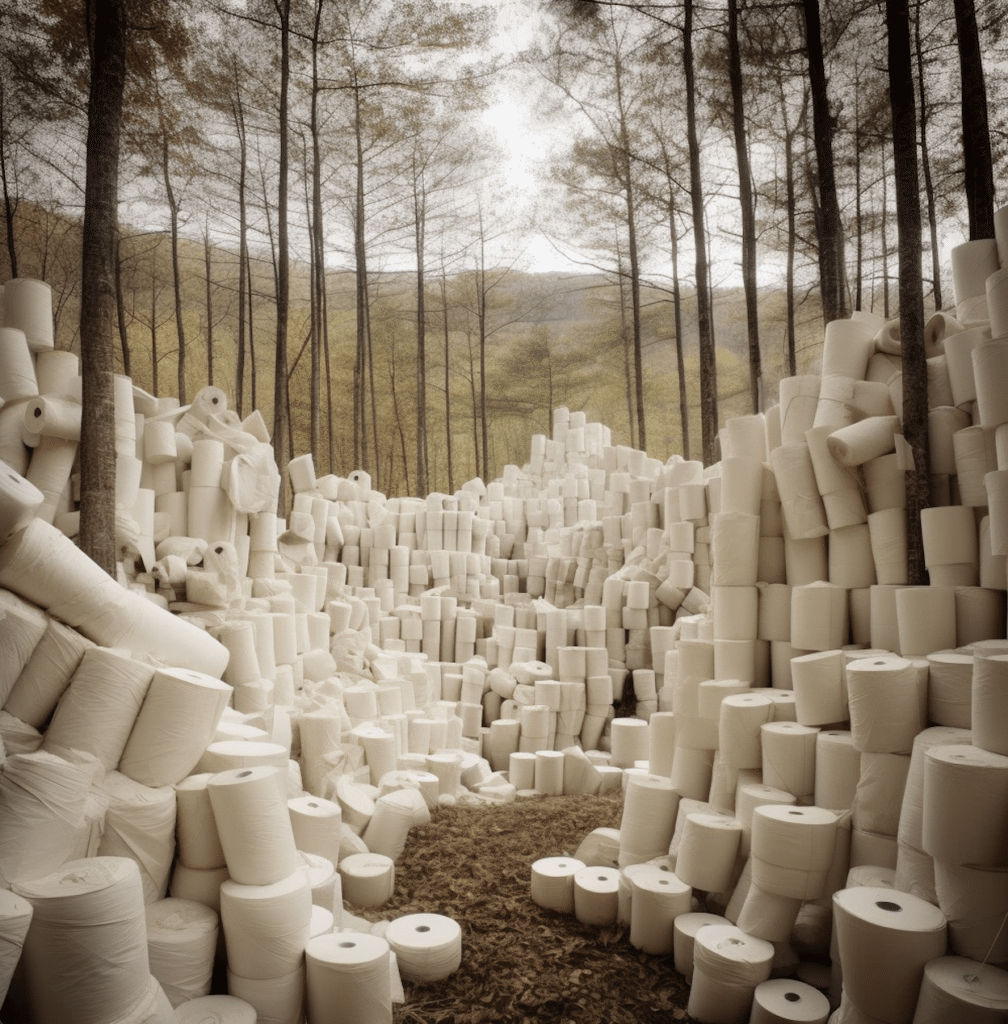
These source of this fiber, virgin forest trees, are one of our front line defenses serving as powerful carbon sinks that absorb large amounts of planet-warming carbon dioxide every year. But let’s take a look at where this information came from and what we can do. And please note, all the things we write here about toilet paper hold true for paper towels, for which we have similarly proposed product solutions for sustainable paper towel alternatives.
Non-Profit Study In 2020 Communicated The Findings
The NRDC, or the Natural Resources Defense Council, is a not-for-profit, tax-exempt membership organization incorporated since 1970 and works studying environmental problems, identifying solutions and communicating with the public. As a result of the COVID-19 pandemic causing a shortage of toilet paper, NRDC carried out a toilet paper study to expose issues of sustainability in the industry. What they found was terrible. Shelly Vinyard, a co-author on the report, says the following:
By making toilet paper from ancient forests essential to the climate fight, tissue companies are flushing away our forests and our planet’s future. Instead of exacerbating the climate crisis, companies like Procter & Gamble must take urgent action to create more sustainable products. Our planet has no time for the largest companies in the world to take half-measures or deflect blame.
Shelley Vinyard, NRDC’s Boreal Campaign Manager and report co-author
Shelley Vinyard’s criticism shows a sense of humor. The reason for the criticism is that NRDC found out, shockingly, that the major brands from the 3 big manufacturers that comprise 80% of toilet paper production, use virgin forest fiber. These are irreplaceable trees from forests that have stood for thousands of years.
Majority Of Toilet Paper Is Made In 4 Countries By 3 Companies
Roughly 90% of the world’s toilet paper is manufactured in just four countries – China, the United States, Brazil, and Canada. These four countries account for the vast majority of global production, with China alone responsible for approximately 40%.
The remaining 10% of toilet paper is produced in more than 60 countries worldwide. Interestingly, while the vast majority of toilet paper is produced in industrialized nations, a significant amount is produced in developing countries such as India, Indonesia, and Pakistan.
Moreover, three companies Proctor & Gamble, Kimberly Clark, and Georgia-Pacific account for more than 80% of the toilet paper produced in the world. There are a few other companies that produce toilet paper, but they have a very small market share.
As part of the NRDC report, 26 brands got grades regarding their sustainability. The major brands, Charmin, Cottonelle, and Quilted Northern— all got F grades, because of their poor sourcing of paper from virgin forest trees.
Americans Use The Most Rolls Per Person
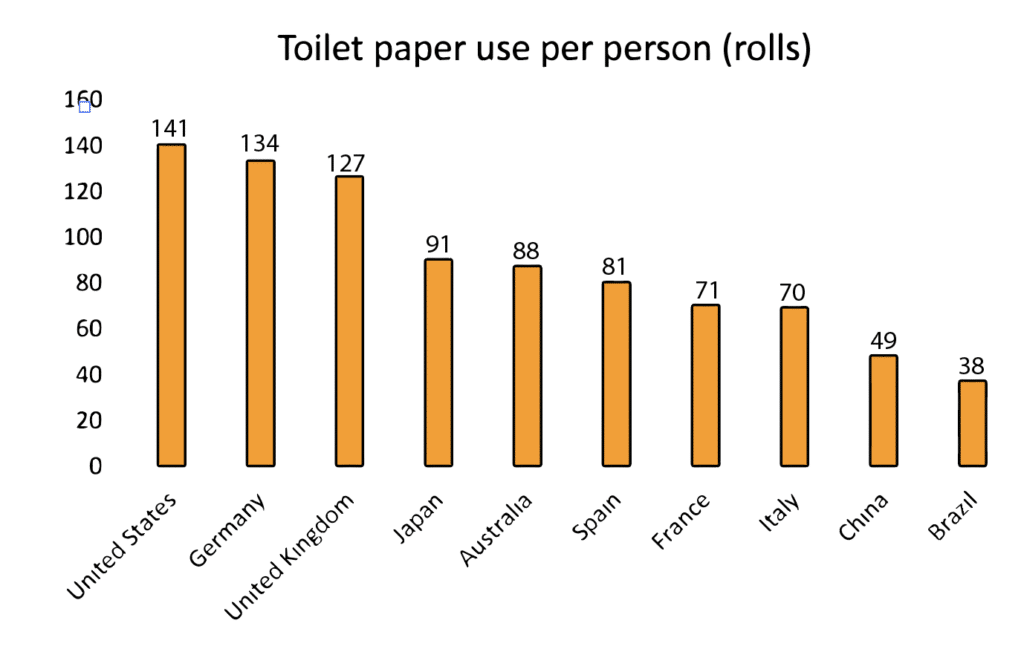
The NRDC published figures for toilet paper use on a per person basis for the top 10 countries. The toilet paper usage per person varies significantly among the top 10 countries, with developed countries generally having higher usage.
The United States, Germany, and the United Kingdom lead in usage, while Brazil has the lowest consumption. Factors such as standard of living, cultural habits, and personal hygiene preferences play a role in these differences. Additionally, countries with a wide range of socioeconomic conditions or preferences for alternative personal hygiene products may have lower toilet paper usage.
Differences in toilet paper usage among countries can be influenced by the prevalence of alternative hygiene practices, such as the use of bidets or water sprays. Bidets are common in countries like France, Italy, and Spain, where they are seen as an efficient and environmentally friendly alternative to toilet paper.
The widespread use of bidets in these countries could explain their relatively lower toilet paper consumption compared to countries like the United States, where bidets are less common.
Japan is well-known for its advanced and widespread use of bidets, particularly in the form of high-tech toilets with built-in bidet functions, commonly known as Washlets. The popularity of bidets in Japan could be a contributing factor to the lower toilet paper consumption compared to countries like the United States, Germany, and the United Kingdom, where bidets are less common.
Toilet Paper Environmental Impact: Daily 27,000 Trees Cut for One Ton Of Toilet Paper
From the NRDC report, now we know most conventional toilet paper is made from wood pulp sourced from old-growth forests. These are the forests that have been around for hundreds or even thousands of years.
And they are home to some of the world’s most biodiverse wildlife. Unfortunately, these forests are being destroyed at an alarming rate to make way for conventional toilet paper production.
How many trees are cut down to make toilet paper? It’s estimated that 27,000 trees are cut down every day to make each ton of toilet paper. Quantitatively, the industry cuts one million acres of boreal forest each year—Russia, Brazil and Canada are at the front.
Removing these trees also permanently removes a carbon sink. That’s also a lot of carbon sinks! And the destruction of old-growth forests isn’t the only issue regarding toilet paper and the environment. Turning tree pulp into toilet paper is energy intensive and emits greenhouse gasses.
NRDC’s 2020 scorecard ranks 26 toilet paper brands, giving an A or A+ score to 11 brands, including the new winner “Who Gives A Crap,” which received the top grade for its rolls made of 100 percent recycled materials, including 95 percent postconsumer recycled product.
Toilet Paper’s Big Negative Impact: Depleting And Not Replacing Carbon-Removing Forests
Most of us use toilet paper daily without giving it much thought. But its clear there are a tragic number of negative factors. Toilet paper is made from trees, and toilet paper production requires cutting down trees and pulping them. This process can have a significant environmental impact, including deforestation, habitat loss, and water pollution.
Toilet paper is wrapped in plastic, contributing to environmental pollution. And, because toilet paper is made from trees, it contributes to climate change. Trees absorb carbon dioxide from the atmosphere and release oxygen, helping to regulate the Earth’s temperature. This process is interrupted when trees are cut down for toilet paper which can contribute to global warming.
Fortunately, there are ways to reduce the environmental impact of toilet paper. You can switch to recycled or bamboo toilet paper, which is more environmentally friendly. Using a bidet or composting toilets can also use less toilet paper. By making small changes in our habits, we can help reduce the environmental impact of toilet paper and make a difference for the planet.
Does Toilet Paper Decompose?
This is a question that many people ask, especially those who are interested in environmental issues. The simple answer is yes, toilet paper does decompose. However, the rate at which it decomposes depends on several factors, including the type of toilet paper and the conditions under which it is buried.
Type is an important factor to consider because different types of toilet paper are made from different materials. For instance, some toilet paper is made from 100% recycled paper, while other brands use the virgin wood pulp.
The recycled paper will decompose more quickly than virgin wood pulp because it is already broken down. Additionally, the type of bleach used also affects decomposition rates. Toilet paper bleached with chlorine will decompose more slowly than unbleached toilet paper.
The conditions under which toilet paper is buried also affect how quickly it decomposes. If toilet paper is buried in anaerobic conditions (without oxygen), it will decompose more slowly than if it is buried in aerobic conditions (with oxygen).
This is because bacteria need oxygen to break down organic matter. Soil composition also affects decomposition rates; for example, sandy soil allows oxygen to penetrate more easily than clay soil, so toilet paper will decompose more quickly in sandy soil than in clay soil.
Toilet paper generally decomposes fully from two weeks to six months. However, as mentioned above, several factors can affect this timeline. Ultimately, the answer to the question “does toilet paper decompose?” is yes – but how quickly it decomposes depends on various factors.
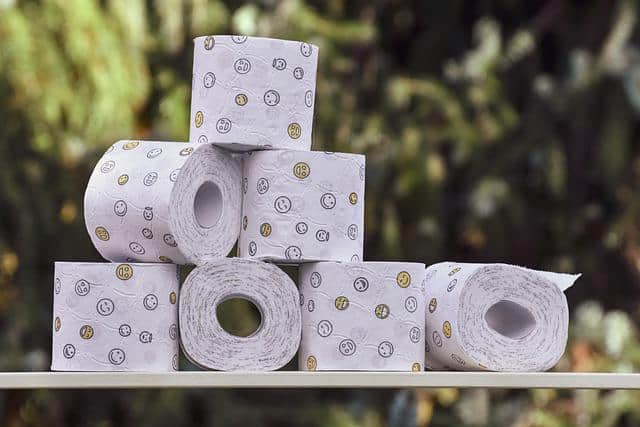
What Are Eco-Friendly Alternatives For Toilet Paper?
ShrinkThatFootprint has compiled an ultimate guide to eco-friendly and recycled toilet paper. Here is a shorter version of the guide. Thanks to the NRDC report, we also know number of brands that got an “A”.
1. Who Gives A Crap 100% Recycled
Made of recycled paper and received A+ rating from NRDC. Price: 24 rolls for $38 or 48 rolls for $62.
2. Green Forest unscented bathroom tissue
Made of recycled paper and received A+ rating from NRDC. They say the rolls are biodegradable but unclear if this means in general toilet paper is biodegradable (true) or it has enhanced biodegradability (e.g. 4 times faster). Price: 12 rolls for $24.
3. 365 Everyday Value, 100% recycled
Made of recycled paper and received A rating from NRDC. As it states and sold by a Whole Foods brand which is now part of Amazon. Price: unavailable due to supply shortage!
4. Natural Value 100% Recycled Bathroom Tissue
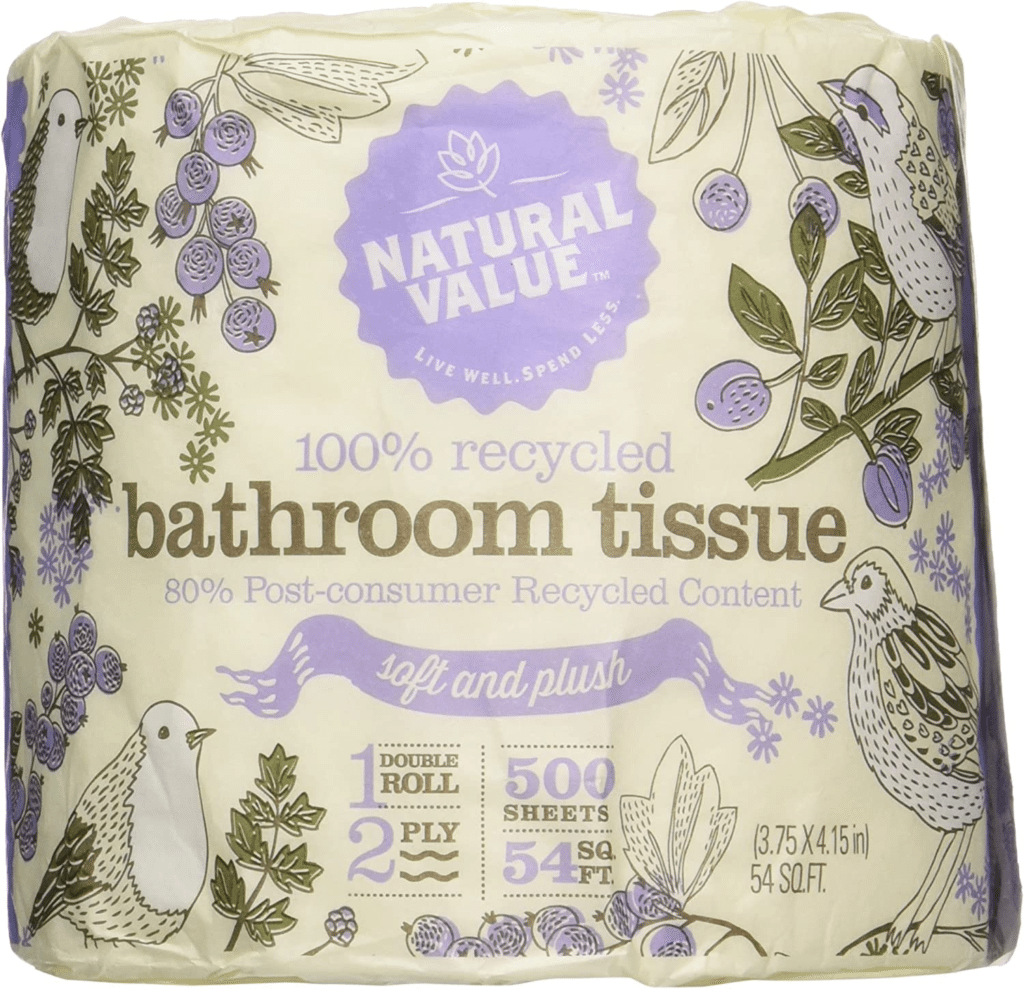
Made of recycled paper and received A rating from NRDC. Hypoallergenic, fragrance and dye-free. They note that the composition is 80% post-consumer recycled paper and 20% pre-consumer recycled paper. More specifically post-consumer recycled paper is from pulp after use by consumers and businesses. In contrast, pre-consumer means the paper was part of commercial processes but never reached consumers. Price: 48 rolls for $57.
5. Seventh Generation Unbleached Recycled Bath Tissue
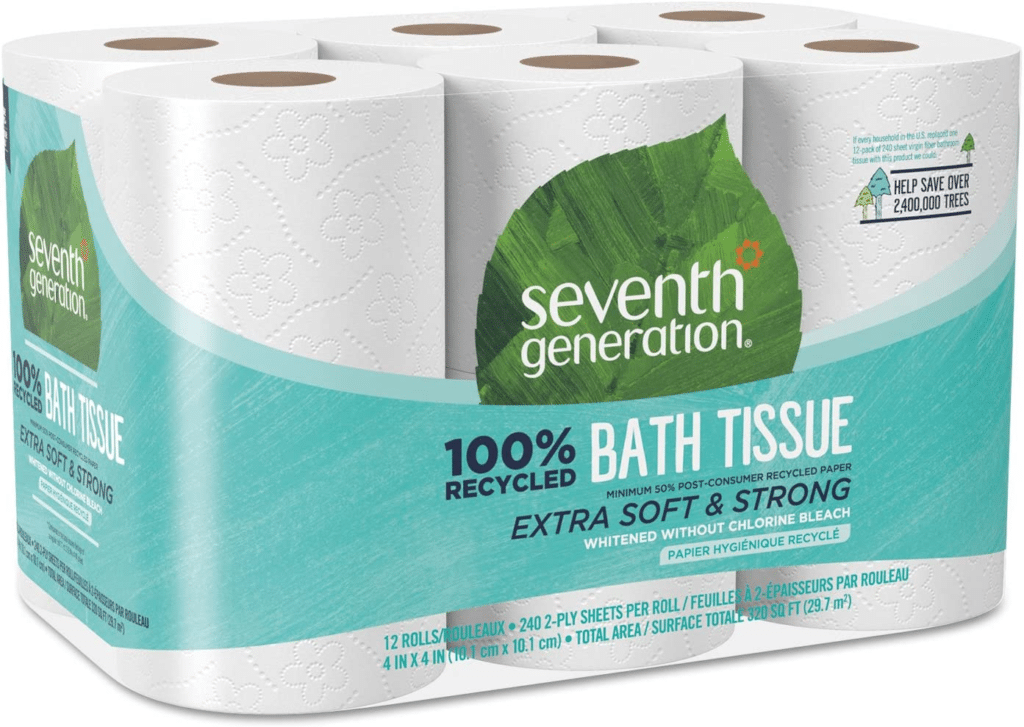
Made of recycled paper and received A rating from NRDC. Whitened using an environmentally progressive process that doesn’t involve bleach. Price: 12 rolls for $19.39.
6. NooTrees Bamboo 3-ply Bathroom Tissue
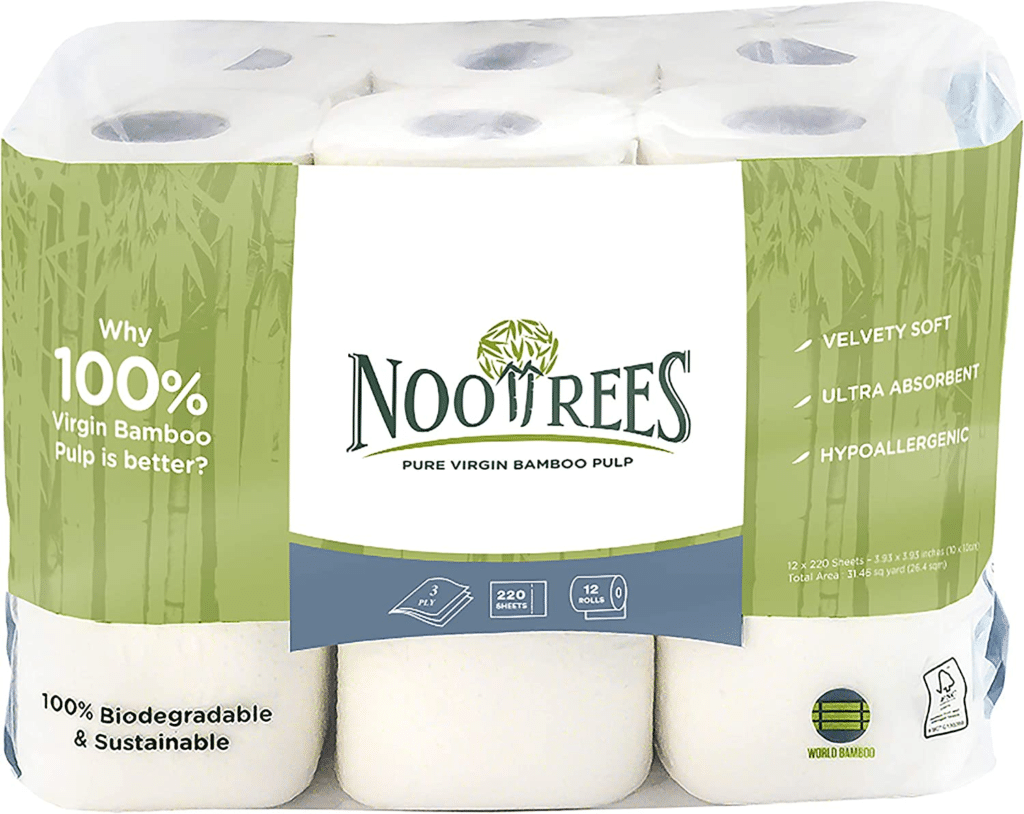
Our first reviewed product made of bamboo. Unlike trees, bamboo harvesting leaves intact the roots which lets the plant spring back quickly. This means that growing bamboo extracts carbon from the air quickly. Couple that with used toilet paper decomposing back into the air means there’s a closed cycle. The remaining question we don’t really know is whether the energy practices of making this type of bamboo tissue is energy efficient. Low comparative energy should be a factor when comparing carbon emissions. Price: 12 rolls for $17.94.
Recycled vs Bamboo Toilet Paper
Recycled toilet paper is made from, well, recycled paper! This means that no new trees have to be cut down to produce it. Bamboo toilet paper is another great alternative that’s not in the top 5 above. Bamboo is a fast-growing grass that doesn’t need pesticides or herbicides to thrive.
It also requires far less water than trees, making it more sustainable. If you’re looking for an eco-friendly way to clean up, ditch the conventional toilet paper in favor of recycled or bamboo varieties. Related, bamboo is also used for tissues, which are not for toilets.
Wrapping Up
Recycling or composting paper is one way to reduce carbon impact of paper. However in the case of toilet paper, after use its sent far downstream to be treated at municipal sewage facilities so it is out of your control. Instead your impact occurs upstream at the point of purchase of the toilet paper.
In conclusion, you know that toilet paper decomposes at different rates depending on the soil type and other conditions. You also know that most toilet paper is made in just four countries and that many eco-friendly alternatives are available if you’re looking to reduce your environmental impact.
So the next time you reach for a roll of toilet paper, remember that you’re using a product that significantly impacts the environment – and choose accordingly!

Anne Lauer
Anna Lauer is a writer, gardener, and homesteader living in rural Wisconsin. She has written for Mother Earth News, Grit, and Hobby Farms magazines. Anna is writing a new book about growing your food for free and an ultimate guide to producing food at little to no cost. When she’s not writing or gardening, Anna enjoys spending time with her husband and two young daughters.
